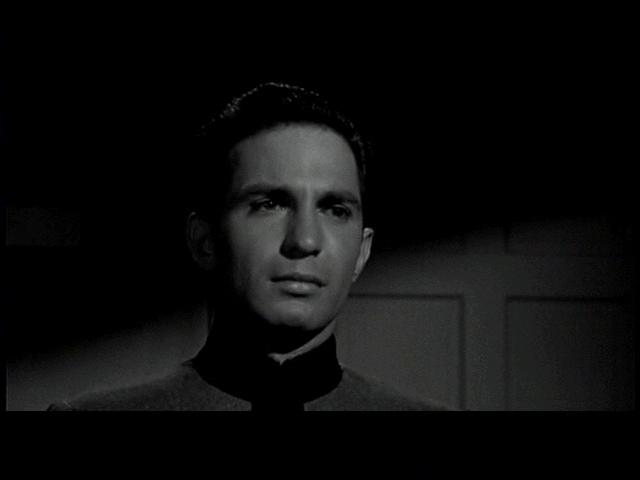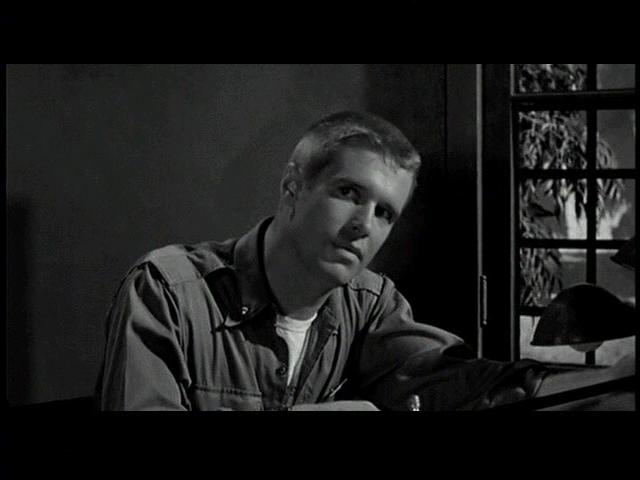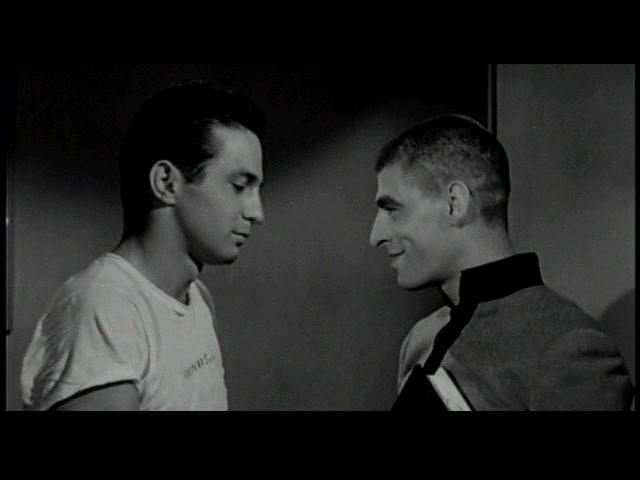|

Synopsis:
At a southern military college, a sadistic bully named Jocko (Ben Gazzara) pressures four of his classmates — Harold (Pat Hingle), Robert (George Peppard), Simmons (Arthur Storch), and Roger (James Olson) — into beating up a freshman (Geoffrey Horne) and pouring liquor down his throat. Much to Jocko’s delight, Horne is expelled for disorderly conduct; but his classmates grow increasingly uncomfortable with their part in the episode, and decide they’ve had enough of Jocko’s manipulative dominance.
|
|
Genres, Themes, Actors, and Directors:
- Ben Gazzara Films
- Bullies
- College
- Falsely Accused
- Military
- Pat Hingle Films
- Play Adaptation
Review:
The Strange One holds a special place in cinematic history, as the first film directed by and starring exclusively members of the New York Actor’s Studio. Based on a novel and play by Calder Willingham, Strange One is a dark, powerful, yet uneven movie — one which is often unpleasant to watch. Perhaps most frustrating are the clearly-missing scenes involving Jocko and “Cockroach” (Paul E. Richards), an obviously homosexual man with designs on Jocko and blackmail up his sleeve; he’s a fascinating character, yet shows up just a few times, and is grossly underused in the script. Equally annoying is Arthur Storch’s terrible, non-Method performance; with his teeth artificially bucked (what an awful choice!), he looks uncomfortable each time he talks, and reminds one of Jerry Lewis.
Fortunately, the remainder of the performances are good enough to distract us from Storch’s misfire. Gazzara is stunning in the lead role (his first on-screen), expertly showing us the worst aspects of humanity through Jocko’s behavior. Also excellent is Pat Hingle as Jocko’s closest friend; watch his face during the scene when he suddenly realizes just how unscrupulous Jocko really is. George Peppard acquits himself admirably in his feature debut, and is perfectly cast as the young cadet who — like everyone else — is scared of Jocko at first, but eventually realizes he has nothing to lose (and everything to gain) by standing up to him. Other bit roles are nicely played as well — including Larry Gates as the expelled cadet’s father, Julie Wilson as a local beauty, James Olson as a hunky football star, and Peter Mark Richman as the leader of the kangaroo court which is convened at the end of the movie. It’s during this final powerful scene when we suddenly realize it was worth it to suffer through Gazzara’s carefully calculated trail of venom, as we finally witness justice being served.
Redeeming Qualities and Moments:
- Ben Gazzara as Jocko

- Pat Hingle as Harold

- George Peppard as Robert

- A brave attempt to depict homosexual undercurrents

Must See?
Yes, for Gazzara’s stand-out performance, and for its importance in cinematic history.
Categories
- Historically Relevant
- Noteworthy Performance(s)
Links:
|
One thought on “Strange One, The (1957)”
A must – and agreed, mainly for Gazzara’s performance and the film’s place in cinema history.
On TCM, it was explained that producer Sam Spiegel valiantly fought the censors – attempting to keep in as much of Willingham’s controversial screenplay as possible. Still, there is the feeling that something is missing here – not only in the case of the character of ‘Cockroach’, but in Gazzara’s case as well; a little more could have been illuminated about his sociopathic nature. Who hasn’t met someone like Jocko, though? And Gazzara nails his role.
In terms of gay imagery in film, ‘Cockroach’ is a bold but still unfortunate representation. There’s something bonkers about him and his hero-worship of Jocko.
Of particular importance here is the often-atmospheric, b&w camerawork of Burnett Guffey – who had a very impressive career and shot quite a few must-sees, inc. ‘In a Lonely Place’, ‘From Here to Eternity’ and (yes), ‘Homicidal’.
On a final gay note: Near the beginning of the film, a cadet walks the grounds at bedtime, stopping in front of dorm doors to ask “All in?” – and getting “All in.” in response each time. Must have been a case of hearing what I wanted to hear, but I kept hearing, “Paul Lynde?” …”Paul Lynde.”
cf: Willingham’s writing for ‘Paths of Glory’, ‘One-Eyed Jacks’ and ‘The Graduate’